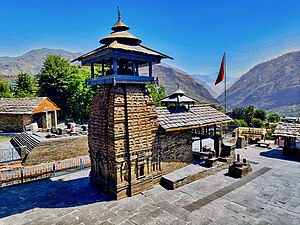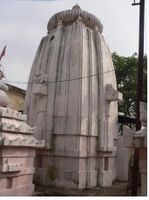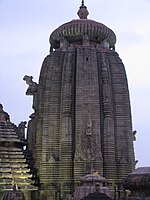
Jagannatha is a deity worshipped in regional Hindu traditions in India as part of a triad along with his (Krishna's) brother Balabhadra, and sister, Subhadra. Jagannath, within Odia Hinduism, is the supreme god, Purushottama, and the Para Brahman. To most Vaishnava Hindus, particularly the Krishnaites, Jagannath is a form of Krishna, sometimes as the avatar of Vishnu. To some Shaiva and Shakta Hindus, he is a symmetry-filled tantric form of Bhairava, a fierce manifestation of Shiva associated with annihilation.

Shikhara, a Sanskrit word translating literally to "mountain peak", refers to the rising tower in the Hindu temple architecture of North India, and also often used in Jain temples. A shikhara over the garbhagriha chamber where the presiding deity is enshrined is the most prominent and visible part of a Hindu temple of North India.

The Jagannath Temple is a Hindu temple dedicated to the god Jagannath, a form of Vishnu in Hinduism and two of his siblings, Balaram and Subhadra, alongside Sudarshan. It is located in Puri in the state of Odisha, situated on the eastern coast of India. As per temple records, King Indradyumna of Avanti built the main temple of Jagannath at Puri. The present temple was rebuilt from the eleventh century onwards, on the site of the pre-existing temples in the compound, but not the main Jagannath temple, and begun by Anantavarman Chodaganga, the first king of the Eastern Ganga dynasty. Many of the temple rituals are based on Oddiyana Tantras which are the refined versions of Mahayana Tantras as well as Shabari Tantras which are evolved from Tantric Buddhism and tribal beliefs respectively. The local legends link the idols with aboriginal tribes and the daitapatis (servitors) claim to be descendants of the aboriginals. The temple is one of the 108 Abhimana Kshethram of the Vaishnavite tradition.

Lingaraja Temple is a Hindu temple dedicated to Shiva and is one of the oldest temples in Bhubaneswar, the capital of the Indian state of Odisha, India. The temple is the most prominent landmark of Bhubaneswar city and one of the major tourist attractions of the state. Shiva's consort and the temple's presiding Goddess, Parvati, is referred to as Annapurna or Girija.

Ratha is the Indo-Iranian term for a spoked-wheel chariot. The term has been used since antiquity for both fast chariots and other wheeled vehicles pulled by animals or humans, in particular the large temple cars or processional carts still used in Indian religious processions to carry images of a deity.

Ananta Vasudeva Temple is a Hindu temple dedicated to Krishna, an avatar of Vishnu located in Bhubaneswar, the state capital of Odisha, India. The temple was constructed in the thirteenth century, and the complete murtis of Krishna, Balarama and Subhadra are worshipped there. The temple dates back to the period of Chandrika Devi, the daughter of Anangabhima III, during the reign of the king Bhanudeva. A commemorative inscription that marked the foundation of the temple can be found in the British Museum's collection.
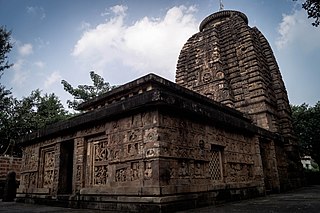
Parsurameswara Temple also spelt Parashurameshvara, located in the East Indian city of Bhubaneswar, the capital of Odisha, India, is considered the best preserved specimen of an early Odia Hindu temple dated to the Shailodbhava period between the 7th and 8th centuries CE. The temple is dedicated to the Hindu god Shiva and is one of the oldest existing temples in the state. It is believed to have been built around 650 CE in Nagara style and has all the main features of the pre-10th century Kalinga Architecture style temples. The temple is one among the Parashurameshvara group of temples.
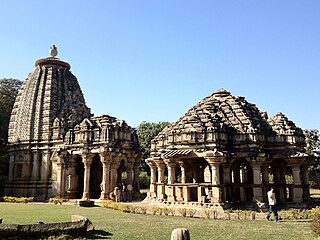
The Baroli Temples Complex, also known as the Badoli temples, is located in Baroli village in Rawatbhata City in Chittorgarh district of Rajasthan, India. The complex of eight temples is situated within a walled enclosure; an additional temple is about 1 kilometre (0.62 mi) away. They are built in the Gurjara Pratihara style of temple architecture dated to the tenth century CE and today show various degree of preservation, decay and destruction. All nine temples are under the control of the Archaeological Survey of India for conservation and protection. A well known art critic characterised "the creations of Badoli as the most perfect of their age that he had encountered within that part of the country and, in their own peculiar style."

Konark Sun Temple is a 13th-century CE Hindu Sun temple at Konark about 35 kilometres (22 mi) northeast from Puri city on the coastline in Puri district, Odisha, India. The temple is attributed to king Narasingha Deva I of the Eastern Ganga dynasty about 1250 CE.

Hindu architecture is the traditional system of Indian architecture for structures such as temples, monasteries, statues, homes, market places, gardens and town planning as described in Hindu texts. The architectural guidelines survive in Sanskrit manuscripts and in some cases also in other regional languages. These texts include the Vastu shastras, Shilpa Shastras, the Brihat Samhita, architectural portions of the Puranas and the Agamas, and regional texts such as the Manasara among others.

Rajarani Temple is an 11th-century CE Hindu temple located in Bhubaneswar, the capital city of Odisha, India. Believed to be devoted to Lord Shiva, the shrine is called Raja Rani because it is made of yellow and red sandstone and the two colors are locally called ‘Raja Rani’.
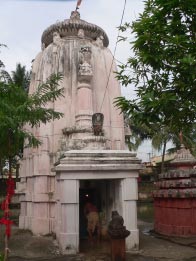
Paradaresvara Siva Temple is a 13th-century AD temple in Bhubaneswar, Odisha. The time period of its construction is estimated from its architectural features and it suggests that the temple must belong to the ganga period. Paradaresvra Siva temple is situated in the Gosagaresvar temple precinct. It is located on the left side of Ratha road old town, Bhubaneswar. It is located at a distance of 1 km west of Lingaraja Temple and 1 km south of Ananta Vasudev, 300 metres southwest of Ramesvara Temple and 200 metres northwest of Vaital Temple. The temple is facing towards east. The presiding deity is only a circular yonipitha in the cella that measures 3 square metres. The lingam is missing.
Kartikesvara Siva Temple is situated at a distance of about 100 m from eastern gateway of Lingaraj temple. It is on the left side of the temple road leading from Lingaraja to Garej Chowk, Bhubaneswar, within the precinct of Gandhi Garabadu which is now under the Lingaraja Temple Administration.

Uttaresvara Siva Temple is a 12th-century Hindu temple dedicated to Lord Siva located in Bhubaneswar, Odisha, India.
Subarnesvara Siva temple is situated on the left bank of the Lingaraja west canal, Bhubaneswar, Orissa, India. The east facing temple enshrines a Siva lingam within a circular yoni pitha in a sanctum measuring 2.35 square meters.
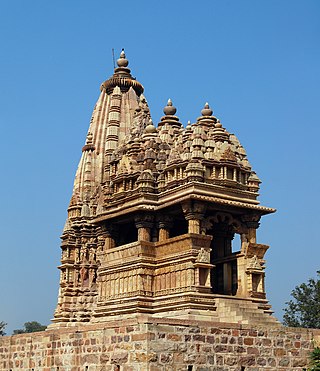
The Javari Temple in Khajuraho, India, is a Hindu temple, which forms part of the Khajuraho Group of Monuments, a UNESCO World Heritage Site. It was built between c. 975 and 1100 A.D.

The Lakshmana Temple is a 10th-century Hindu temple built by Yashovarman during the Chandela dynasty located in Khajuraho, India. It is dedicated to Vaikuntha Vishnu - an aspect of Vishnu. As part of the Khajuraho Group of Monuments, and owing to its architecture and religious importance, the temple was inscribed on the UNESCO World Heritage List in 1986.

A Hindu temple is a pancharatha when there are five ratha or paga on the tower of the temple. The rathas are vertical offset projection or facets. The name comes from the sanskrit Pancha (=five) and Ratha (=chariot), but the link with the concept of chariot is not clear.

Deula is an architectural element in a Hindu temple in the Kalinga architecture style of the Odishan temples in Eastern India. Sometimes the whole temple is also referred to as Deula. The word "deula" in Odia language means a building structure built with a particular style that is seen in most of the temples from Odisha. Deul is also used in English, though the deul temples are also of a different form in the Manbhum region of Western Bengal.



